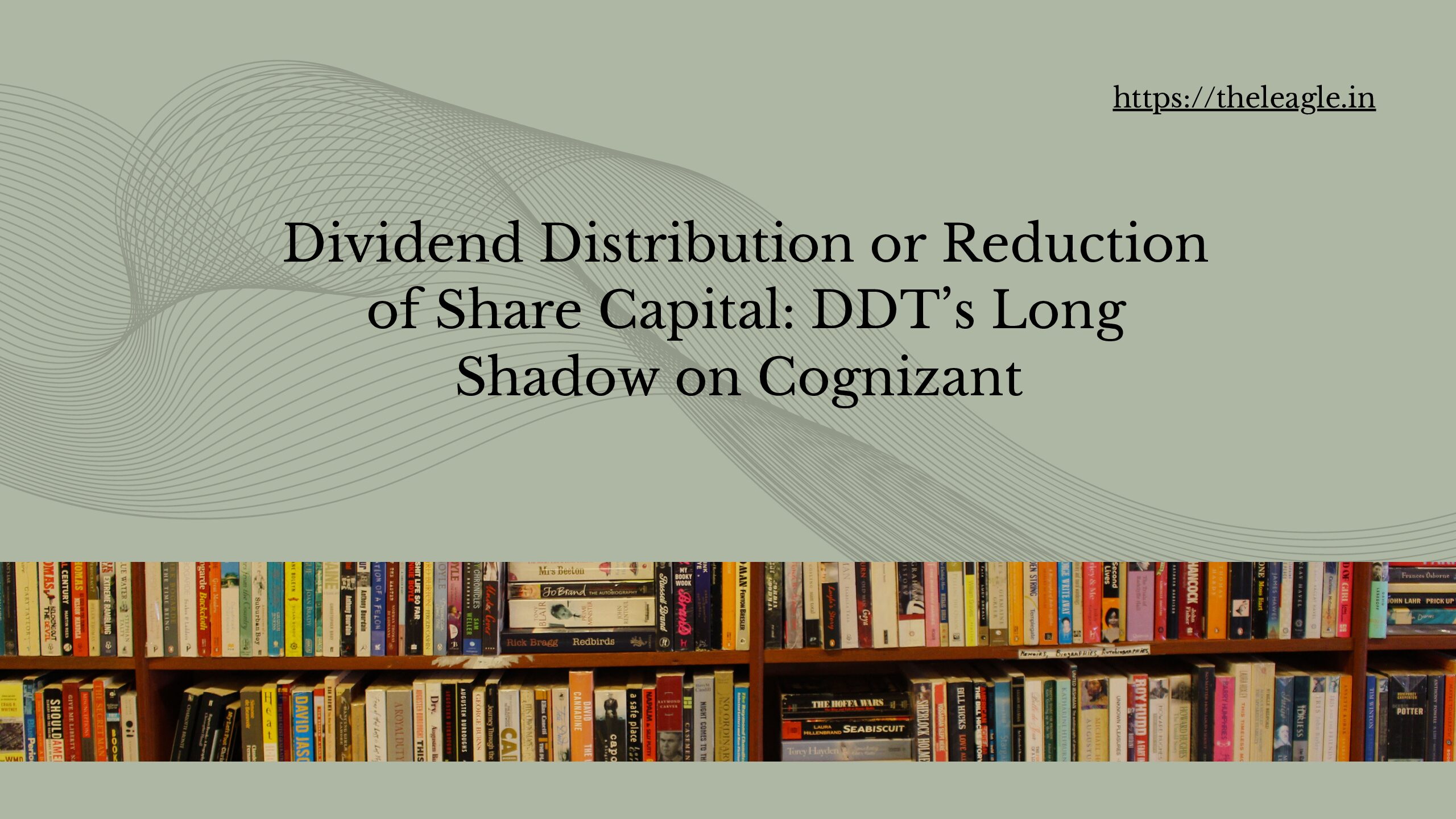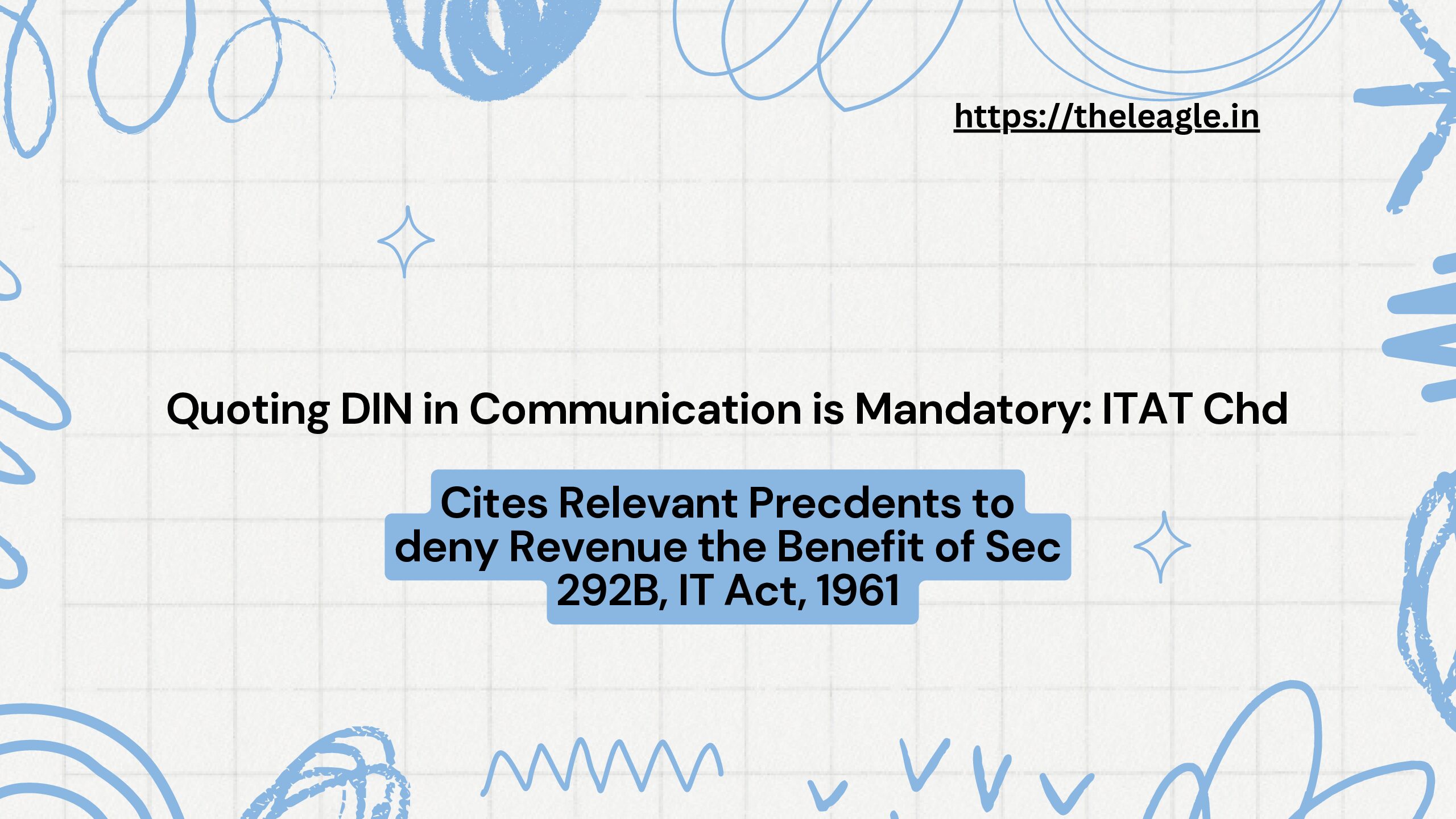Dividend Distribution Tax (‘DDT’) – abolished in April 2020 – was one of the most contested taxes in India as it taxed dividends in hands of companies which distributed dividends. Making companies liable to pay dividend tax was opposite to widely followed classical system of dividend taxation wherein dividends are taxed in the hands of shareholders. The various questionable policy reasons for introduction of DDT aside, DDT also created incentives for companies to find innovative ways to put money in the hands of its shareholders without declaring dividends. One such alternative way was buyback of shares. The alternate means of transferring money in hands of shareholders has been questioned in various cases, most recently and prominently in the Cognizant ruling by ITAT Chennai – currently under appeal before the Madras High Court – where Cognizant was held liable to pay DDT of Rs 19,000 crores (appx.). I look at ITAT’s decision and analyze whether ITAT has imposed tax liability on Cognizant based on persuasive reasons or otherwise.
Scheme of Amalgamation and Tax Payments
M/s Cognizant Technology Solutions India Pvt Ltd. (‘assessee’) purchased its own shares from non-resident shareholders under a ‘Scheme of Amalgamation & Compromise’ sanctioned by the Madras High Court under sections 391-393 of the Companies Act, 1956. The scheme was sanctioned in April 2016, when DDT was still in force. The result of the scheme and buyback of shares by the assessee was that the shareholding of its Mauritius based shareholders increased while that of the US-based shareholders decreased. Thus, a significant capital base of the assessee moved to Mauritius because of the scheme. Though the assessee maintained that its reasons for restructuring were corporate structure streamlining, improving earnings per share, reduce fluctuations in terms of foreign currency fluctuations, and improving overall capital structure of the company.
After approval of the scheme, in Financial Year 2016-17, assessee bought back 94,00534 equity shares of face value of Rs 10 each from its shareholders at a price of Rs 20,297/ per share. Assessee deducted TDS before making payments to the US -resident shareholders since their capital gains arose in India but did not withhold tax for its shareholder resident in Mauritius because the transaction was not liable to tax in India as per the India-Mauritius DTAA.
Revenue’s Arguments for Levy of DDT
The Revenue’s contention was that the consideration paid by assessee to its own non-resident shareholders comes within the ambit of Section 2(22)(a)/2(22)(d) of the IT Act, 1961 and the assessee is liable to pay DDT under Section 115-O of the IT Act, 1961.
Section 2(22)(a) of the IT Act, 1961 defines dividend to include any distribution by a company to its shareholders to the extent of accumulated profits of the company, whether capitalized or not, whether such distribution entails release by the company all or any part of the assets of a company. Section 2(22)(d) further includes within the definition of dividend any distribution made to the shareholders by a company on reduction of its share capital to the extent company possesses accumulated profits.
Revenue Department’s argument was that the sum paid by the assessee after approval of its scheme by the High Court was akin to distribution of accumulated profits by a company to its shareholders, whether capitalized or not, and was taxable under Section 2(22(a), IT Act, 1961. Alternatively, the Revenue Department argued that the consideration paid by the assessee on purchase of its own shares was akin to distribution of accumulated profits on reduction of its share capital and was taxable under Section 2(22)(d), IT Act, 1961. Either way, the Revenue Department’s argument was that the consideration paid was on reduction of share capital amounted to dividend as defined under IT Act, 1961 and was thus taxable under Section 115-0 of the IT Act, 1961.
Assessee Resists Levy of DDT
One of the assessee’s arguments was that Section 2(22)(a)/2(22)(d) are not attracted in the impugned case since distribution of profits would imply absence of quid pro quo. While in the current case there was an offer by the company and acceptance by the shareholders and therefore there is no ‘distribution’ of profits in the true sense. Further, the provisions require that the reduction of capital should be co-terminus with distribution of profits, while in the impugned case the reduction was a result of scheme approved by the High Court. ITAT rejected both prongs of the argument: first, it noted that distribution does not require quid pro quo or lack thereof, only requirement is that the payment and disbursal of profits should be made to more than one person; second, the ITAT held that the assessee is trying to assign a hyper-technical meaning to ‘reduction of share capital’ and to attract Section 2(22)(a)/2(22)(d), it is immaterial if the reduction is a result of the scheme or otherwise.
Assessee’s second argument was that once the scheme was approved by the High Court, the approval operated in rem and was binding on the Revenue Department. The scheme could not be re-characterised by the Revenue Department to levy taxes on the assessee. The ITAT clarified that the approval of the scheme is subject to the condition that it does not grant immunity to the assessee from payment of taxes. Also, the High Court in approving the scheme only acts an umpire to note if the conditions prescribed under the statutory provisions have been met. Finally, the ITAT clarified that the Revenue Department is not seeking to recharacterize the scheme but merely analyse its tax implications. And assessee cannot legitimately argue that the scheme once approved by the High Court excludes the applicability of IT Act, 1961.
Assessee further contended that the reduction of its share capital was sui generis under Sections 391-393 of Companies Act, 1956 and not under Section 77. Thereby, it was taxable only via buyback tax provided under Section 115QA, IT Act, 1961. Section 115QA included only buyback of shares under Section 77A in its scope and included all other forms of buyback in its scope only from 2016 onwards. The assessee’s contention was that its buyback was not under Section 77A but under Sections 391-393 and thus the transaction was not taxable under Section 115QA. ITAT dismissed assessee’s categorization of its transaction and held that no buyback of shares can take place solely under Sections 391-393 and the buyback is necessarily read with section 100-104. Thus, no buyback of shares can take place under Sections 391-393 alone. Finally, ITAT concluded that all forms of buyback – except under Section 77A – are included in the definition of dividend since they entail release of assets of a company. And since assessee’s buyback – by its own admission is not under Section 77A – the distribution of consideration is covered by the definition of dividend.
Use of ‘Colorable Device’ by Cognizant
ITAT was clear and unambiguous in its conclusion that the assessee adopted a colorable device to evade taxes. ITAT noted that the ‘real intent’ of the scheme was to artificially shift the capital base of the company to Mauritius. The other reasons cited by the assessee to streamline corporate structure, increase earnings per share were discounted by ITAT. Further, ITAT noted, assessee was wished to evade taxes by resorting to buyback under general provisions instead of specific provisions, since latter would have triggered their liability to tax. Thus, ITAT concluded:
Therefore, from the facts of the present case, it is undoubtedly clear that the scheme as such is only a colourable device intended to evade legitimate tax dues. Such colourable devices which do not have any commercial purpose can be excluded for physical nullity and the AO empowered to ‘look through’ rather ‘look at’ the transactions. This is further established by the fact that there is no commercial nexus between the company activities and Mauritius and this fact has been specifically dealt by the lower authorities. (para 43)
The cumulative factors led ITAT to conclude that the scheme amounted to distribution of accumulated profits, the consideration paid amounts to dividend under Section 2(22)(a)/2(22)(d) read with Section 115-O and thus is taxable under the IT Act, 1961.
‘Tax Exemption’ Enjoyed by Cognizant
Another fact, though should have been irrelevant, was found germane to the issue by ITAT. The ITAT noted that the assesee had enjoyed ‘tax exemption’ of Rs 30,000 crores (appx) as the assessee has accumulated profits of Rs 33,000 crores (appx) and has not declared interim dividend since 2006-07. (para 31) The assumption in this statement is that the assessee by not declaring dividends was enjoying tax exemption, since under DDT regime, tax was payable by a company only on declaration of dividend. The fact that wasn’t articulated by ITAT was that DDT was introduced to disincentivize companies from declaring dividends and encourage them to invest their profits in growth of the companies. So, fulfilling the objective of DDT amounted to enjoying a tax exemption? Also if the taxable event under DDT is distribution of dividends, and a company chooses not to distribute dividends, how does it amount to a company enjoying ‘tax exemption’? It is at best a case of tax planning. A company can choose not to declare dividend if it feels it will add to its tax liability. The decision not to declare dividend hardly amounts to ‘enjoying’ a tax exemption. Whether the impugned buyback of shares amounts to distribution of dividends should have been interpreted on its own terms, rather than making prior dividend policy of the assessee relevant to determine its tax liability.
Conclusion
ITAT relied heavily on the facts to characterize assessee’s transaction as a colorable device intended to evade tax under the IT Act, 1961. The use of general provisions of Sections 391-393 instead of specific provision of Section 77A to buyback its shares, hyper technical interpretation of reduction of capital and distribution of profits, all were interpreted against the assessee to term the scheme as a colorable device intended to evade DDT. The factual matrix – as captured in ITAT’s decision – certainly doesn’t seem to favor the assessee and even the definition of dividend is wide enough to include the distribution of profits – even if as part of buyback – under the scope of DDT. Whether the arguments and facts are argued and interpreted in a different manner in the High Court and whether any other factors are considered in determining the tax liability of assessee will be known soon.
But, ITAT seems to have stacked the odds against assessee especially by making it prior dividend policy relevant to the impugned case. However, ITAT’s decision is heavily reliant on the interpretation of the definition of dividend which inter alia includes distribution of profits, a stipulation which is certainly fulfilled in the current case. The assessee’s arguments that there was quid pro quo and thus there was no distribution of profits, and that reduction of share capital was a result of the scheme and not co-terminus with distribution do not hold much water. The assessee’s arguments come across as ‘hyper-technical’ as ITAT rightly pointed out. It is to be seen whether assessee adopts alternate or additional arguments in the High Court.


